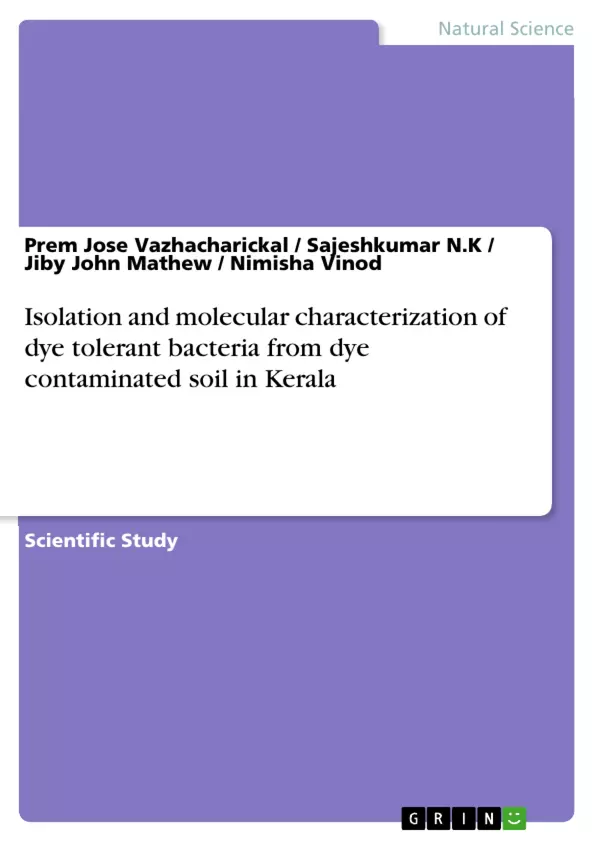The dyes are complex chemical compounds that imparts colour to substances. On the urge of urbanisation, the use of synthetic dyes is increasing largely and its untreated effluent release causes serious environmental pollution affecting water bodies by disturbing the aquatic ecosystem, soil, plants, animals, humans. The recalcitrant nature of these dyes limits its treatment using conventional methods wherein biological methods using microorganisms are reported to completely mineralize the dyes lowering the release of degradation products.
The present work focuses on the biodegradation of synthetic dyes by isolating bacteria from a dyeing unit. Soil samples from the dye contaminated soils was collected, its degradation potentiality was observed using three major dye of studies congo red, brilliant green and methylene blue within 24 hr incubation. Maximum decoloarized dye (congo red and brilliant green) were chosen, serially diluted to 10-5 and plated to obtain two distinct colonies from decolorized congo red (CR1, CR2) and three distinct colonies from decolorized brilliant green (BG1, BG2, BG3). These isolates were biochemically characterized.
Molecular characterization was performed by isolating DNA from five isolates and amplified it using PCR, with the 16s rRNA gene primer. The PCR amplification product having approximately 1500bp were sequenced, edited and searched using BLAST against the known sequences within NCBI databases. The isolates were identified to be CR1 as Pseudomonas (88% identity), CR2 as Aeromonas (89% identical) and BG1/BG2 were confirmed to belong to same genus as Bacillus (99% identical). The phylogenetic tree showed a clear divergence between isolated species. Furthermore, the dye tolerance of isolates were observed by optimization analysis to be as CR1 and CR2 tolerated up to 4% of congo red dye and among BG1, BG2 and BG3; BG1 tolerated up to 0.50% of brilliant green dye. Thus, CR1 and CR2 were observed to be potent azo dye decolourizers. Recombinant DNA Technology can be applied in this field that can make the above future application more reliable.
Inhaltsverzeichnis (Table of Contents)
- Isolation and molecular characterization of dye tolerant bacteria from the dye contaminated soil in Kerala.
- Abstract
- Introduction
- Objectives
- Scope of the study
- Review of literature
- Hypothesis
- Materials and Methods
- Study area
- Soil sample collection
- Quantitative analysis of microorganisms present in the collected soil
- Preliminary screening of dye tolerant microorganisms from soil
- Isolation of potential dye decolourizers
- Morphological and biochemical tests
- Optimization of the dye concentration
- Molecular identification and isolation of DNA
- Quantification of DNA
- Agarose gel electrophoresis
- PCR amplification using 16S rRNA
- Data sequencing
- Data analysis
- Cross evaluation of bacterial isolates and MTCC
- Statistical analysis
- Results and discussion
- Isolation of microorganism from soil
- Preliminary screening of dye tolerant bacteria
- Isolation of potential dye decolourizers
- Pure culture preparation, morphological and biochemical identification
- Optimization of dye concentration
- Bacterial DNA isolation
- PCR amplification using 16s rRNA and sequencing
- Sequence analysis
- Molecular phylogenetic analysis using maximum likelihood method
- Cross evaluation of bacterial isolates and MTCC
- Conclusions
- Acknowledgements
- References
Zielsetzung und Themenschwerpunkte (Objectives and Key Themes)
This research project aims to isolate and characterize bacteria tolerant to dyes from dye-contaminated soil in Kerala. The study investigates the potential of these bacteria to decolorize dyes and explores their molecular identification and phylogenetic relationships.
- Isolation and characterization of dye-tolerant bacteria from contaminated soil.
- Evaluation of dye decolorization potential of isolated bacterial strains.
- Molecular identification and phylogenetic analysis of the isolates.
- Optimization of dye degradation conditions for potential biotechnological applications.
- Contribution to understanding the microbial diversity and bioremediation potential of contaminated environments.
Zusammenfassung der Kapitel (Chapter Summaries)
- Introduction: This chapter introduces the research project, highlighting the significance of dye pollution and the potential of dye-tolerant bacteria for bioremediation. The objectives and scope of the study are outlined.
- Materials and Methods: This chapter details the methodology used for the study, including soil sample collection, dye tolerance screening, isolation and identification of bacterial strains, molecular analysis, and data analysis.
- Results and discussion: This section presents the findings of the study, including the isolation of dye-tolerant bacteria, their decolorization activity, and the molecular characterization of selected isolates. The results are discussed in relation to previous research and potential applications.
Schlüsselwörter (Keywords)
The key terms and concepts explored in this research include dye pollution, bioremediation, dye-tolerant bacteria, bacterial isolation, molecular characterization, phylogenetic analysis, 16S rRNA sequencing, and decolorization potential.
- Quote paper
- Dr. Prem Jose Vazhacharickal (Author), Sajeshkumar N.K (Author), Jiby John Mathew (Author), Nimisha Vinod (Author), 2017, Isolation and molecular characterization of dye tolerant bacteria from dye contaminated soil in Kerala, Munich, GRIN Verlag, https://www.grin.com/document/359357



